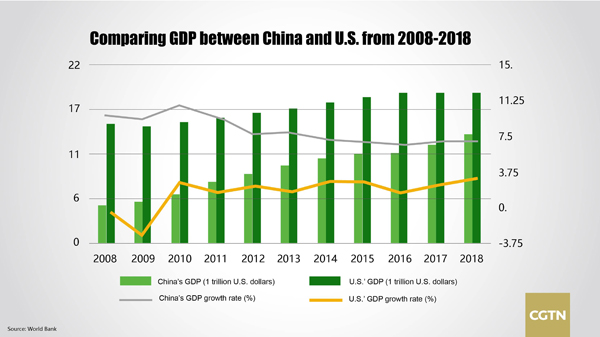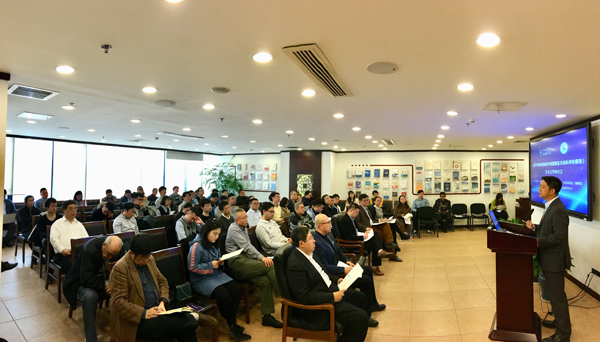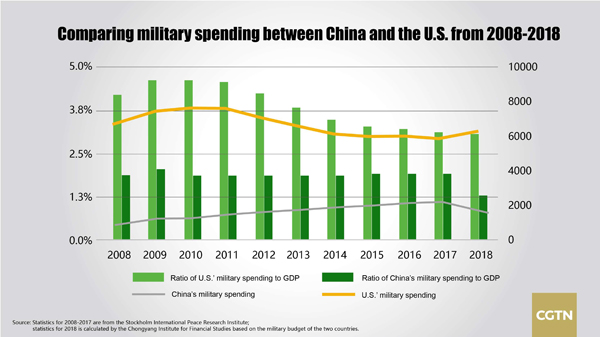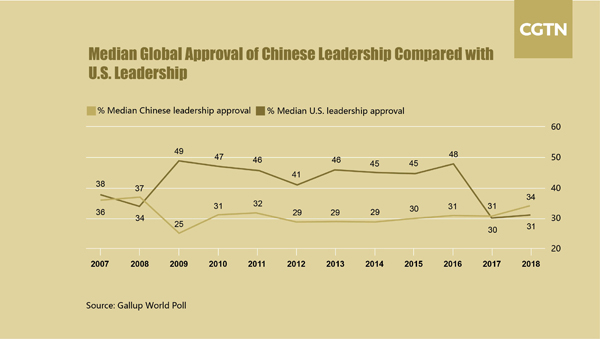Picture
Your Present Location: HOME> PictureWill the Shining City upon a Hill fall to the Middle Kingdom?
Source: CGTN Published: 2019-3-12
While the China-U.S. trade talks have seemingly come to a pause after the deadline for a tariff hike was extended another 60 days, Chinese Vice Premier Liu He held a phone call on Tuesday with U.S. Treasury Secretary Steven Mnuchin and U.S. Trade Representative Robert Lighthizer over key issues and upcoming arrangements. This might give a confidence boost to global markets at a time when there's speculation that a mercurial Trump is walking away from a looming trade deal.
In the midst of such uncertainty, the rest of us can only ask: where will the trade row go from here? Do the U.S. and China have to be confrontational against each other even though their economies swell in unison and their innovation capacities are edging closer?
A shining city upon a hill vs. a middle kingdom
China, or the "Middle Kingdom," was for most of history one of the top players in the global economy. The United States, across the pond, was called "a shining city upon a hill" by former president Ronald Reagan in the 1980s. But over the past decade, more scholars started contending that there are other cities upon other hills, particularly given the rejuvenation drive of China.

CGTN Photo
The past decade has been volatile for Beijing-Washington ties as a transition in power seems to be roiling the existing world order. But it provides us with an opportunity to scrutinize what led to the fluctuations in the world's most important bilateral ties.
The gap between the sizes of the two economies has been shrinking. The U.S.' GDP accounted for 24.2 percent of the world total in 2018, almost the same as 10 years ago when the proportion stood at 23.2 percent, while China's GDP rose from 7.2 percent to 15.9 percent over the same period, according to a report recently released by the Chongyang Institute for Financial Studies.

Report released at the Chongyang Institute for Financial Studies of Renmin University of China on March 10
Last year, China's GDP was about 66 percent of that of the U.S., in a continuously upward trend since 2014, when it surpassed 60 percent of the world's largest economy for the first time. However, America still retains its crown in the world economy at 20.5 trillion U.S. dollars (China stood at 13.6 trillion U.S. dollars in 2018). Moreover, Washington's military budget in 2018 accounted for 3.08 percent of its GDP, 3.6 times that of China.

CGTN Photo
Regarding hi-tech exports, China saw a rise from 25.57 percent in 2008 to 28.8 percent in 2018, while the U.S. experienced a decline from 25.2 percent to 14 percent. But the U.S. has a far more comprehensive system of innovation, buoyed by tens of thousands of research labs, the report notes.
In terms of a crucial gauge of soft power, a Gallup poll from February shows that China's global approval rating has surpassed that of the U.S., possibly due to Trump's withdrawal doctrine. However, Beijing's power of discourse, which has though enormously enhanced, still falls behind that of Washington, especially in a multitude of international organizations.

CGTN Photo
Can the two powers forge ahead with peace?
So the U.S., with both its hard power and soft power still sitting upon a hill, will unlikely teeter over the short run. "Power, like love, is easier to experience than to define or measure,” wrote American political scientist Joseph Nye. It's unlikely to give a quantitative definition to "power" which is, in a way, erratic.
"We can say China's GDP is 66 percent of the U.S., but we cannot say how much power it has of the U.S.," said Da Wei, a professor at the University of International Relations in Beijing. Now that Beijing has geared up to share Washington's unipolar world, it should keep sober-minded while maintaining its confidence, added the China-U.S. watcher.
In this new world, building reputation through diplomatic rapport may be more effective than strategic strong-arming.
"Credibility is what we should cultivate because sometimes it can play a bigger role than power," underlined Wang Honggang, director of the Institute of American Studies at China Institutes of Contemporary International Relations.
Sometimes we delve too much into the differences between China and the U.S., focusing on their different political systems, developmental stages and cultures, all while ignoring that the two countries share many values in this modern world. The rise and fall of bilateral relations is cyclical, but their demise doesn't have to be inevitable.























































































 京公网安备 11010802037854号
京公网安备 11010802037854号





